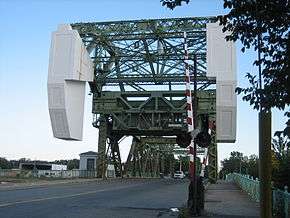Cherry Street Strauss Trunnion Bascule Bridge
| Cherry Street Strauss Trunnion Bascule Bridge | |
|---|---|
|
The Cherry Street Bascule Bridge | |
| Carries | vehicluar and pedestrian |
| Crosses | Toronto Harbour Shipping Channel |
| Locale | Toronto |
| Other name(s) | Cherry Street Bridge |
| Owner | Ports Toronto |
| Maintained by | Ports Toronto |
| Heritage status | |
| Type | listed |
| Designated | February 25, 1992 |
| Characteristics | |
| Design | Bascule |
| Material | Steel |
| Total length | 120 metres |
| Width | 20m |
| Height | > 48 metres |
| Longest span | 40 metres |
| Clearance above | 48 metres |
| Clearance below | Toronto Harbour Ship Channel |
| History | |
| Architect | Joseph Strauss |
| Designer | Joseph Strauss |
| Engineering design by | Joseph Strauss |
| Constructed by | Dominion Bridge Company |
| Fabrication by | Dominion Bridge Company |
| Construction end | 1930 |
| Construction cost | CA$500,000 |
| Inaugurated | 1930 |
| Opened | 1930 |
The Cherry Street Strauss Trunnion Bascule Bridge is a bascule bridge and Warren truss in Toronto, Ontario, Canada.[1] Located in the industrial Port Lands area, it carries Cherry Street over the Toronto Harbour Ship Channel and opens to allow ships to access the channel and the turning basin beyond. There are two bascule bridges on Cherry Street. The other, smaller bridge, crosses the Keating Channel, while this bridge crosses the Ship Channel.
The bridge was built in 1930 [1] by the company of Joseph Strauss and the Dominion Bridge Company. The north side of the bridge has 750-ton concrete counterweights that allow the bridge to pivot to open. The bridge uses 500 tons of steel in its construction.[2] The bridge is designed to carry two lanes of traffic. It cost CA$500,000 ($7.73 million in 2016 dollars)[3] to build.[2] It was officially opened on June 29, 1931 by Toronto Mayor William Stewart.[2] The bridge was listed under the Ontario Heritage Act by the City of Toronto in 1992 as architecturally historical.[4]
The city spent CA$2.5 million to refurbish the bridge in 2007.[5] The Toronto Port Authority made further repairs on the bridge from December 2012 to September 2013 at a cost of CA$2 million.[6]
See also
References
- 1 2 Kuitenbrouwer, Peter (September 13, 2013). "After nine months of repairs this Toronto bridge is finally open for business again, sort of". National Post. Retrieved September 15, 2013.
- 1 2 3 Toronto Harbour Commission Public Affairs Department 1985, p. 51.
- ↑ Canadian inflation numbers based on Statistics Canada. "Consumer Price Index, historical summary". CANSIM, table (for fee) 326-0021 and Catalogue nos. 62-001-X, 62-010-X and 62-557-X. And Consumer Price Index, by province (monthly) (Canada) Last modified 2016-01-22. Retrieved March 2, 2016
- ↑ "Cherry St". Toronto Heritage Properties Inventory. City of Toronto. Retrieved 2009-02-16.
- ↑ "That Old Blue Bridge". Unknown Victoria. 2009-08-27. Retrieved 2012-03-26.
Steel bridges, especially ones with intricate latticework like ours, contain thousands of difficult-to-reach joints, often hiding corrosion that’s accelerated by salty air. Repairing and repainting such bridges is an ongoing headache, especially compared to ones made of concrete. Nevertheless, some places re-invest in their old steel bridges. Toronto refurbished its Cherry Street Bridge for $2.6 million in 2007, and recently Boston and San Francisco spent tens of millions renovating their Strauss drawbridges as well.
- ↑ Kuitenbrouwer, Peter (September 13, 2013). "After nine months of repairs this Toronto bridge is finally open for business again, sort of". National Post.
- Bibliography
- Filey, Mike (1998). Discover & explore Toronto's waterfront: a walker's, jogger's, cyclist's, boater's guide to Toronto's lakeside sites and history. Dundurn Press. ISBN 978-1-55002-304-6. OCLC 39678576.
- Toronto Harbour Commission Public Affairs Department (1985). Toronto Harbour – The Passing Years. Toronto, Ontario: Toronto Harbour Commissioners.
Coordinates: 43°38′29″N 79°20′56″W / 43.641302°N 79.349023°W
